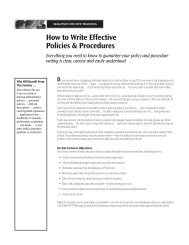Precision Thinking and Problem-solving Skills - SkillPath | Seminars
Precision Thinking and Problem-solving Skills - SkillPath | Seminars
Precision Thinking and Problem-solving Skills - SkillPath | Seminars
- No tags were found...
You also want an ePaper? Increase the reach of your titles
YUMPU automatically turns print PDFs into web optimized ePapers that Google loves.
SKILLPATH <strong>Seminars</strong><br />
Course Overview<br />
<strong>Precision</strong> <strong>Thinking</strong> <strong>and</strong><br />
<strong>Problem</strong>-<strong>solving</strong> <strong>Skills</strong><br />
<strong>Problem</strong> <strong>solving</strong> foundations<br />
• Identify the qualities of a good problem solver/<br />
decision maker<br />
• Distinguish Quadrant II problems (important/<br />
not urgent) from Quadrant I, III <strong>and</strong> IV problems<br />
in order to eliminate crisis management <strong>and</strong><br />
reactive problem <strong>solving</strong><br />
• Explain how to apply the seven steps involved in<br />
the problem-<strong>solving</strong> process<br />
<strong>Problem</strong> identification <strong>and</strong> analysis<br />
• Find out how to properly identify a problem<br />
that needs to be solved <strong>and</strong> the critical questions<br />
that must be answered before you tackle<br />
any problem<br />
• How to use a Pareto Analysis to determine which<br />
problems to solve <strong>and</strong> in what order<br />
• How to contain the impact of virtually any<br />
problem you may encounter<br />
• Why it’s important to collect data to analyze a<br />
problem <strong>and</strong> why most people want to skip<br />
this step<br />
• Underst<strong>and</strong>ing the different types of data that are<br />
collected during a problem analysis<br />
<strong>Precision</strong> thinking skills for the<br />
best solutions<br />
• How to use brainstorming <strong>and</strong> mind mapping<br />
tools to generate potential solutions<br />
• The four methods most commonly used to select<br />
the best solution<br />
• The keys to planning <strong>and</strong><br />
implementing solutions<br />
Risk analysis<br />
• How to perform a risk analysis<br />
• How to determine your risk readiness<br />
Evaluating your results<br />
• The right way to evaluate the results of<br />
your solution<br />
• What the Shewhart Cycle is <strong>and</strong> how it applies to<br />
problem <strong>solving</strong><br />
• Why it’s important to celebrate your success<br />
Root cause analysis <strong>and</strong> monitoring<br />
• How to perform a root cause analysis<br />
• Underst<strong>and</strong>ing the difference between normal<br />
<strong>and</strong> abnormal process variation<br />
• How to use a control chart to monitor a process
















